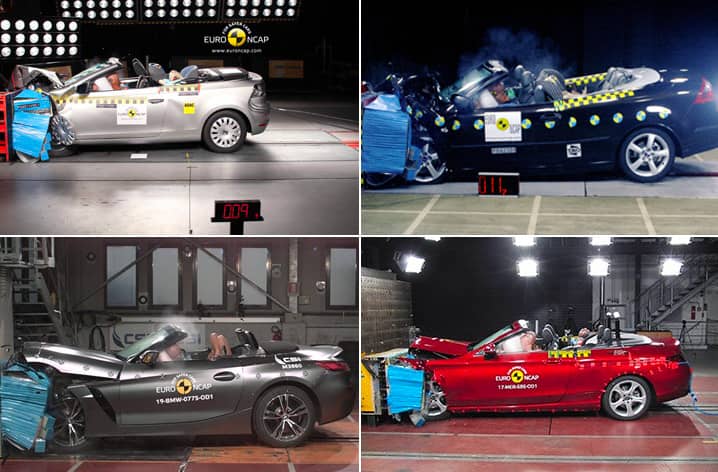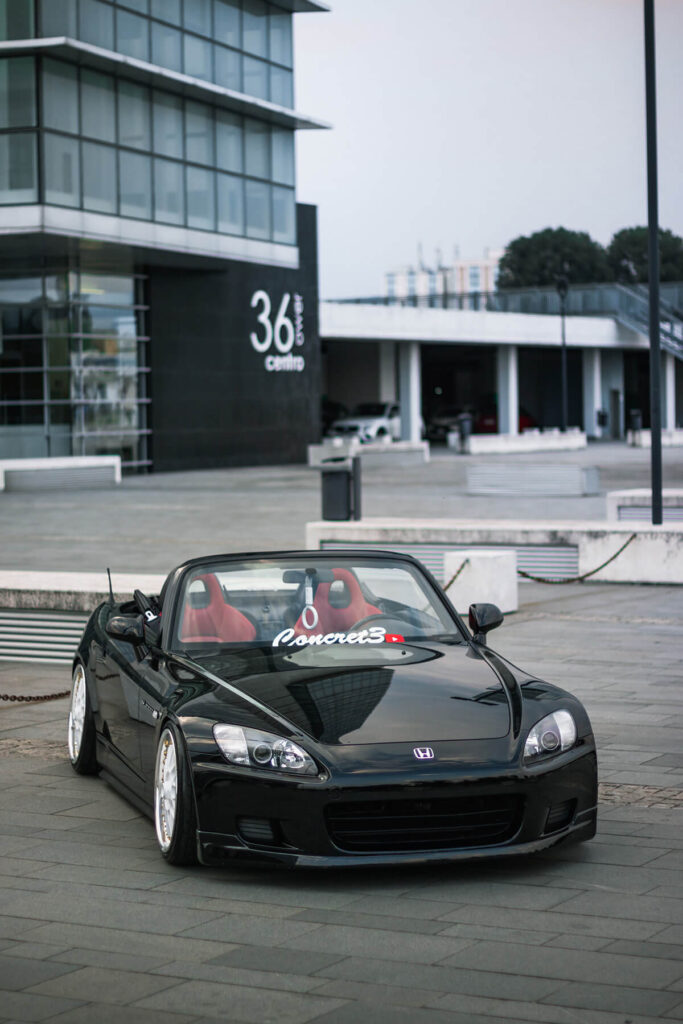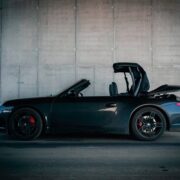Are Convertibles Cars Safe? Crash Risk Based on Numbers

Open top cars evoke feelings of fun, freedom, and leisure. Who doesn’t love cruising down backroads with the top down on a sunny day? However, the exposed nature of convertibles compared to hardtop vehicles raises reasonable safety concerns. Are they less safe than their closed-roof counterparts?
While it’s true convertibles lack the protective roof structure found in most vehicles, advanced safety features and design improvements have enhanced safety significantly in recent years. In this post, we’ll explore the latest crash statistics, how open top car safety has evolved, remaining vulnerabilities, and safety ratings for today’s convertible models.
Key Takeaways
- Recent studies don’t indicate higher fatality rates for modern open top cars
- Reinforcements, pop-up bars, and reinforced chassis now augment safety
- Smart precautions are still essential for managing increased convertible risks
The Perception vs Reality
Many people assume cabriolets are inherently less safe due to their lack of a rigid roof structure. However, the reality is more nuanced. While these cars do face some increased safety risks in certain collision types, they have advanced safety features to help mitigate those vulnerabilities.
| Safety Concern | Reality |
| Roof strength | Lack rigid structure but have reinforcements and pop-up bars |
| Ejection risk | Present in high speed crashes but rare overall |
| Rollovers | Average level of risk |
When equipped with side curtain airbags, seat belt pretensioners, and anti-roll bars, convertibles can protect occupants well. Drivers also play a major role through defensive driving and smart precautions. By understanding the realities around convertible safety, you can make informed decisions.
Crash Statistics: Are Convertibles More Dangerous Than Regular Cars?
Analyzing real-world crash data by provides useful insights into convertible safety. Here are some key statistics:
- Convertibles had 11% lower driver death rates per 10 billion vehicle miles traveled compared to nonconvertibles, although this difference was not statistically significant. They also had 6% lower driver involvement in police-reported crashes per 10 million vehicle miles traveled.
- On average, convertibles were driven 1,595 fewer miles per year than nonconvertible versions. This indicates lower overall crash exposure that may contribute to lower death and crash rates.
- Among fatal crashes, convertibles showed slightly higher ejection rates, although the number of rollovers was small and rollover rates did not substantially differ between convertibles and nonconvertibles.
- Driver behaviors like speeding, alcohol impairment, and seat belt use were nearly equivalent in fatal crashes between convertibles and nonconvertibles. This suggests the safety limitations of convertibles rather than behavioral differences account for any increased ejection risk.
- Modern convertible safety systems like reinforced A-pillars and roll bars, as well as improved roof strength standards since 2000s, appear to have reduced the historical increased risk of convertible crashes. Their current real-world driver death rates now approach parity with standard models.
In summary, while a minor increased ejection risk remains, recent convertibles do not demonstrate markedly higher driver death (11% lower) or crash involvement (6% lower) rates compared to nonconvertible counterparts when accounting for lower average annual mileage. Continued safety system improvements may mitigate residual ejection risks.

The Role of Roof Structures in Convertible Safety
The primary safety advantage of metal or rigid polymer roof structures is preserving survival space in a crash. By limiting intrusion from roof collapse, closed vehicles better protect occupants. However, reinforcements in modern convertible make them far safer than decades ago. Key enhancements include:
- Reinforced A-pillars: Stronger pillars secured with high-strength steel help maintain roof integrity.
- Added bracing: Supports along the doors, rear quarters, and windshield frame provide rigidity.
- Pop-up roll bars: Automatically deploy to provide overhead coverage in rollovers.
While convertibles still lack the full protection of a rigid roof, smart engineering provides formidable safety advancements.
Ejection Risks in Convertibles
Since convertibles lack side windows and a roof, a common perception is occupants getting ejected in high speed crashes. However, federal data shows ejections occur in some collisions when drivers neglected safety precautions. Furthermore, advanced restraint systems help secure occupants. Key features minimizing ejections include:
- Pre-tensioning seatbelts: Cinches belts tight in the first inches of rapid deceleration.
- Side airbags: Deploy to cover side windows and doors in side impacts.
Properly worn seatbelts are critical for managing the increased ejection hazards in convertibles while driving defensively also reduces risks.

Are Convertibles Safe in a Roll Over?
Due to their higher mass, convertibles may be more prone to rollovers. However, reinforcements in the windshield frame, A-pillars, and transmission tunnel help channel collision forces down through the frame.
| Vehicle | Body Style | Rollover Risk | NHTSA Test Link |
| 2011 BMW 328i | Convertible (RWD) | 9.30% | Link |
| 2011 BMW 328i | 2 Door (RWD) | 9.30% | Link |
| 2011 Chevrolet Camaro | Convertible (RWD) | 8.70% | Link |
| 2011 Chevrolet Camaro | 2 Door (RWD) | 8.70% | Link |
| 2023 Ford Mustang | Convertible (RWD) | 8.10% | Link |
| 2023 Ford Mustang | Coupe (RWD) | 9.30% | Link |
According to this data, convertible versions of selected models did not have a higher rollover crash risk. In the case with the 2023 Mustang, the soft top version of it even has a lower roll-over risk, probably because of the lower center of gravity.
Safety Research Based on EURONCAP Data
Euro NCAP or European New Car Assessment Programme is an organization that conducts safety assessments on new vehicles sold in Europe. Some key points about Euro NCAP:
- It is an independent vehicle safety testing organization founded in 1997.
- They conduct crash tests and evaluations of collision protection and safety features on new passenger vehicles in Europe.
- Euro NCAP publishes safety ratings on vehicles out of 5 stars, which provides a comparison of relative vehicle safety for consumers.
- Their testing and ratings are considered very influential in Europe. High Euro NCAP ratings are used as a safety credential by automakers in marketing to customers.
- They test important safety aspects like occupant protection in frontal/side crashes, pedestrian protection, seat belts, airbags, crash avoidance features, and more.
Here is a table summarizing the Euro NCAP safety ratings for various BMW Z4 and Mazda MX-5 Miata model years:
| Vehicle | Model Year | Euro NCAP Safety Rating |
| BMW Z4 | 2019 | 5/5 stars |
| BMW Z4 | 2015 | 3/5 stars |
| BMW Z4 | 2004 | 4/5 stars |
| Mazda MX-5 Miata | 2015 | 4/5 stars |
| Mazda MX-5 Miata | 2002 | 4/5 stars |
This table shows the Euro NCAP overall safety ratings on a 5-star scale for selected BMW Z4 roadsters and Mazda MX-5 Miata convertibles across different model years. The 2019 BMW Z4 received the highest 5-star rating, while the 2015 BMW Z4 received the lowest 3-star rating among the vehicles tested. The Mazda MX-5 Miata earned consistent 4-star ratings across the 2002 and 2015 model years.
Based on the EURONCAP safety rating data for 2-seater roadsters.
Their specialized expertise highlights how modern engineering safeguards convertible occupants while personal responsibility and defensive tactics further reduce risks.
Key Takeaways
- Expert researchers highlight the promise of safety enhancements in newer convertibles
- Top-rated models from IIHS and NHTSA confirm design improvements safeguard occupants
- Personal responsibility is still pivotal in managing the inherent risks
Expert Opinion
As someone who has joyfully owned convertibles for over a decade, I can attest to the huge strides in safety technology. Today’s reinforced frames, advanced restraints, and rollover protection systems make newer models incredibly protective while retaining all that open-air magic. With responsible driving, modern safety advances now let convertible drivers laugh in the face of heightened risks compared to the past. While you give up some security versus metal roofs, robust construction and vigilant driving empower safer top-down motoring. I firmly believe open top cars can deliver practical, worry-free daily transportation, bur just a bit riskier than conventional cars – we’ve come a long way from worrying if tin-tops meant tin can safety!
Other Studies. Look up more statistic data in convertible car related studies and researches in our special feature. Here you’ll find the recent information on safety, production numbers, drivers demographics, and impact on our emotional state: Beyond the Buzz: Facts, Studies & Researches About Convertibles
Conclusion
While convertibles face inherent vulnerabilities lacking a rigid roof, advanced engineering combined with smart driving greatly improve occupant protection. Modern structural reinforcements, rollover bars, side airbags, and reinforced chassis provide safeguards absent just 10-15 years ago. Evaluate your risk tolerance and priorities, but the latest designs allow convertible lovers to enjoy top-down driving with manageable trade-offs. For more guidance on ownership, check our recommendations on maintenance and operating precautions.
Frequently Asked Questions
Some of the most prominent sources are IIHS (Insurance Institute for Highway safety), NHTSA and Euro NCAP.
Cabriolets provide advanced occupant protection including side airbags, seatbelt pretensioners, reinforced frames, and rollover protection. Leading safety organizations have given high marks to recent cabriolet models. However, the lack of a roof structure means cabriolets face increased ejection risks requiring vigilant driving and seatbelt use to mitigate.
Many modern convertibles have side curtain airbags that deploy to cover the doors and side passenger areas. BMW, Mercedes-Benz, and other automakers now offer head-protecting side airbags as an advanced safety feature. Side airbags help reduce partial ejection risks.
Many new convertible models have pop-up style roll bars that automatically deploy in the event of a rollover. The roll bars activate using sensors to provide overhead protection comparable to permanent roll bars. This system preserves cargo space while offering emergency coverage when needed.
Similar to convertibles, cabriolets weigh approximately 100-300 lbs more than their fixed-roof counterparts. Compact 2-seat cabriolets often weigh around 3,000-3,400 lbs. Larger 4-seat cabriolets can reach 3,700-4,100 lbs. The exact weight depends on the vehicle size, engine, and model-specific reinforcements.
The added reinforcements in convertibles for occupant protection increase their curb weight. The materials to anchor seatbelts and deploy airbags also add mass. Automated pop-up roll bars have mechanisms that increase weight as well. The fabric tops also make the chassis heavier to offset stability reductions.
In-house writer and editor at CabrioNation. I've been a lifelong fan of convertibles ever since my first car, a well-worn Bimmer convertible that I learned to maintain from the ground up. Since then I've owned many soft and hard top models, becoming an experienced DIY mechanic and care taker. I also run a small repair shop and rental service in Montpellier, where I get to share the wind-in-your-hair feeling with customers while also helping fellow cabrio enthusiasts on maintenance and top repairs.



Love this! As a lifelong convertible junkie, it’s reassuring to see how far safety tech has progressed. I’ll take reasonable risks for the sheer ecstasy of top-down driving.